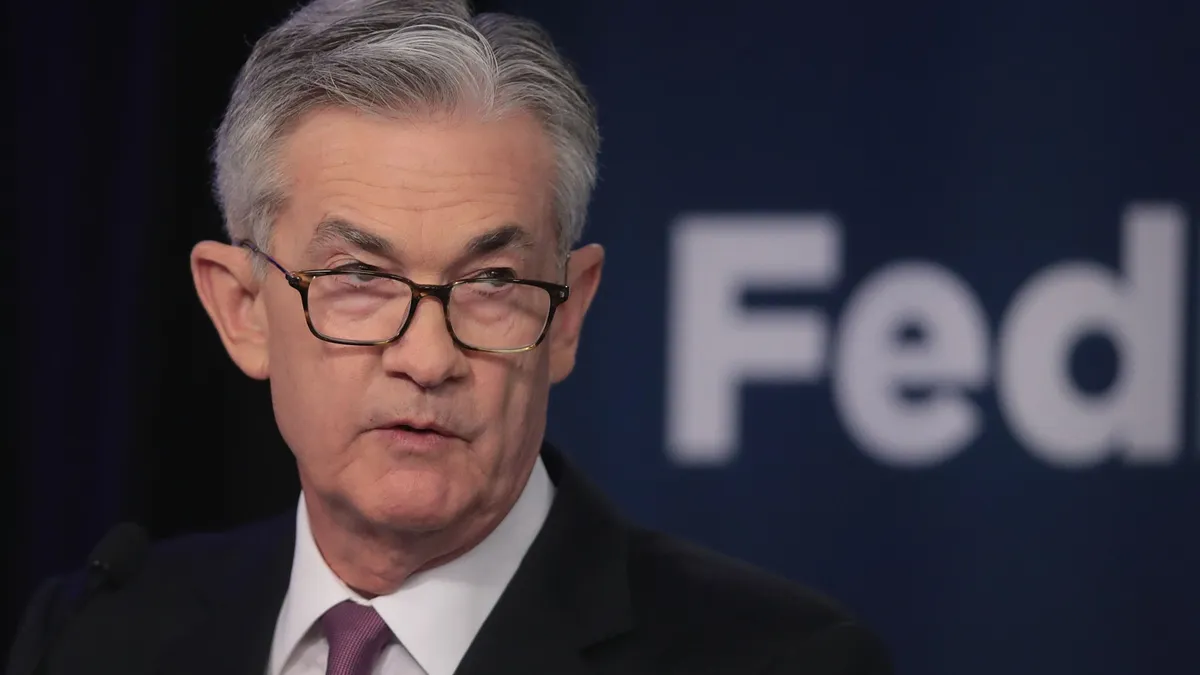Dive Brief:
- The Federal Reserve on Wednesday held the benchmark interest rate steady at a 22-year high while keeping the door open to a future rate hike.
- The Fed for the second consecutive meeting left the federal funds rate unchanged at a range between 5.25% and 5.5%. Several policymakers have recently noted that a surge in U.S. Treasury yields since September may ease price pressures in coming weeks by slowing robust hiring and economic growth.
- “Tighter financial and credit conditions for households and businesses are likely to weigh on economic activity, hiring and inflation,” policymakers said in a statement following a two-day meeting. “The extent of these effects remains uncertain,” they said after a unanimous policy decision.
Dive Insight:
Fed Chair Jerome Powell said during a press conference that policymakers have made progress in easing price pressures but have more work to do before hitting their 2% inflation target.
“We are committed to achieving a stance of monetary policy that is sufficiently restrictive to bring inflation down to 2% over time, and we’re not confident yet that we have achieved such a stance,” he said.
Recent higher-than-forecast vitality in the labor market, consumer spending and economic growth complicate Fed efforts at restoring price stability.
U.S. job openings in September rose more than expected for a second consecutive month, with available positions increasing to 9.6 million, the Bureau of Labor Statistics said Wednesday in its Job Openings and Labor Turnover Survey. Layoffs fell while hiring rose.
“I think everyone has been very gratified to see that we’ve been able to achieve, you know, pretty significant progress on inflation without seeing the kind of increase in unemployment that has been very typical of rate hiking cycles like this one,” Powell said.
Strength in the labor market has exceeded Fed expectations and undergirded greater-than-projected consumption and growth in U.S. gross domestic product.
GDP surged at a 4.9% annual pace during the third quarter, largely fueled by a 4% gain in consumer spending, the Commerce Department said last week. Consumer outlays rose just 0.8% during Q2.
“Economic activity has been expanding at a strong pace and well above earlier expectations,” Powell said, noting that the Fed economists are not forecasting a recession. “Evidence of growth persistently above potential, or that tightness in the labor market is no longer easing, could put further progress on inflation at risk,” he said.
Despite many signs of economic vigor, inflation this year has eased toward the Fed’s 2% target. The core personal consumption expenditures price index — the Fed’s preferred inflation measure — fell on an annual basis to 2.8% from April through September compared with 4.5% during the previous six months.
At the same time — in a change highlighting the mixed signals confronting policymakers — core PCE in September rose 0.3% compared with just 0.1% in August.
“Inflation has moderated since the middle of last year and readings over the summer were quite favorable,” Powell said. “But a few months of good data are only the beginning of what it will take to build confidence that inflation is moving down sustainably toward our goal.”
The policy-making Federal Open Market Committee in its statement on Wednesday kept further tightening on the table. “The committee would be prepared to adjust the stance of monetary policy as appropriate if risks emerge that could impede the attainment of the committee’s goals.”
Powell during the press conference put a finer point on the committee’s statement.
“It’s fair to say that the question we’re asking is, ‘Should we hike more?’” he said. “We’re very focused on getting confident that we have achieved a stance of monetary policy that is sufficiently restrictive — that’s really our focus.”
In late September Fed officials forecast one more quarter percentage point increase in the main interest rate this year.
Since then the bond market has reinforced the Fed’s inflation fight, with the yield on the 10-year Treasury note rising about 0.5 percentage points to 4.8%. The yield is the benchmark for corporate bonds, mortgages and other financing.
Tighter financial conditions from higher Treasury yields, falling equity prices and a stronger dollar would only influence monetary policy if they persist, Powell said. Also, “they can’t simply be a reflection of expected policy moves from us.”
“In the meantime, though, perhaps the most important thing is that these higher Treasury yields are showing through real higher borrowing costs for households and businesses, and those higher costs are going to weigh on economic activity,” Powell said.















